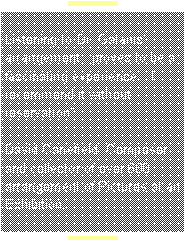|
George Galanis was born in Melbourne in 1959. He started playing the violin when he was four years old, and the piano when he was five, eventually studying piano and music theory with Joan Voumard, a leading Melbourne pianist and teacher at that time. Listening to Dr. Galanis’ arrangement for piano, orchestra, chorus and organ proves to be a fascinating experience: It is quite unlike any other orchestration that I have heard. Despite the size of the forces, the full ensemble is not often used, nor is the piano, which often takes a solo role, found in every movement. From almost the beginning, there are surprises: witness the unearthly glissandi at the beginning of “Gnomus.”
Galanis proves to be an accomplished and sensitive pianist, to the point that I would welcome a solo piano version by him. Even though his recording, in some sense, cannot be considered a “live” recording (see his notes above), I would never have guessed that the piano portions were not recorded directly from someone playing the actual instrument. The orchestra parts are also very well done (being played also in real time by the arranger), but are recognizably not actual instruments. They are, at least, good synthesized approximations thereof, and in a few places (e.g., the beginning of Promenade 4), could almost fool me into thinking “real instruments.” Galanis has taken some liberties with the score, rewriting occasionally (“Il vecchio castello”), fading out (as in the end of “Bydlo”), the very fast tempo of the middle section of “Baba-Yaga,” etc., but to these ears it’s all done in good taste, and piques ones desire to hear a live performance of this work done with real instruments. “Ballet of Unhatched Chicks” will provide another surprise in the exceedingly fast trills in the piano. I have no idea how these were accomplished: They seem superhuman. If there is any part of this orchestration that I have the least bit of hesitation about, it is “Limoges,” wherein the interplay between solo piano and orchestra seems a bit arbitrary.
Given the success of many of the new arrangements, and many conductors’ willingness to move away from the ubiquitous Ravel, Dr. Galanis ought to have no great difficulty in finding some enterprising orchestra willing to take this on. In the meantime, this CD is well worth exploring by anyone who is jaded either with the Ravel orchestration, or even by the exceedingly numerous original piano versions, and I can recommend it without reservation. |



|
Pictures at an Exhibition |
|
Reviews |
|
© George Galanis 2008 |